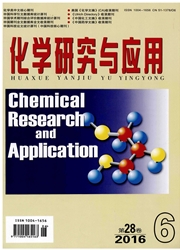

 中文摘要:
中文摘要:
将市售活性炭经过硝酸、过氧化氢及不同温度进行处理后用于苯的羟基化反应,并研究了活性炭催化苯羟基化反应机理.用Boehm滴定,N2吸附-脱附及X射线光电子能谱对活性炭进行了表征.结果表明,反应体系的pH对催化剂活性具有重要的影响,活性炭对苯的吸附受表面含氧基团含量的影响.模型化合物反应结果表明,活性炭表面的酚羟基和羰基是反应的活性位,两者可相互转化,并在一定的pH条件下达到平衡,该转化使得H2O2活化为羟基自由基,进而与苯反应生成苯酚.在苯羟基化反应中,活性炭表现出良好且稳定的催化性能,苯酚收率可达14.4%.
 英文摘要:
英文摘要:
Phenol is widely used in industry.The hydroxylation of benzene to phenol can meet the increasing requirement for phenol and green chemistry.Commercial wood-based activated carbon was treated by different methods,including oxidation by nitric acid and hydrogen peroxide and thermal treatment at different temperatures,and used as the catalyst for the hydroxylation of benzene to phenol in acetonitrile using H2O2 as oxidant.The mechanism of the hydroxylation was also investigated.The activated carbon samples were characterized by Boehm titration,nitrogen adsorption,and X-ray photoelectron spectroscopy.The pH had a significant effect on the phenol yield.The effect of benzene adsorption was also investigated.Several model compounds with oxygen groups were used as catalysts for the hydroxylation of benzene.The reaction between phenolic hydroxyl and quinone on the surface of activated carbon was responsible for the hydroxylation of benzene to phenol when it activated H2O2 to form the hydroxyl radical.Activated carbon was an efficient and stable catalyst and a maximum phenol yield of 14.4% was obtained under the optimal reaction conditions.
 同期刊论文项目
同期刊论文项目
 同项目期刊论文
同项目期刊论文
 Sodium metavanadate catalyzed direct hydroxylation of benzene to phenol with hydrogen peroxide in ac
Sodium metavanadate catalyzed direct hydroxylation of benzene to phenol with hydrogen peroxide in ac Low temperature hydroxylation of benzene to phenol by hydrogen peroxide over Fe/activated carbon cat
Low temperature hydroxylation of benzene to phenol by hydrogen peroxide over Fe/activated carbon cat 期刊信息
期刊信息
